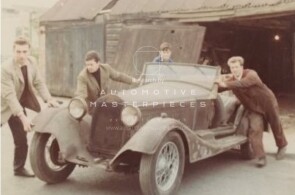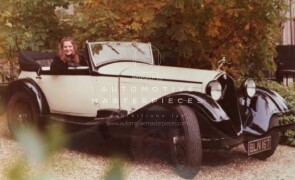
1933 Alfa Romeo 6C 1750 Gran Sport
ON/OFF
Why am I an Automotive Masterpiece?
L. Limited edition cars
no. 41 manufactured, 37th built
In the early 1920s Vittorio Jano was entrusted by Alfa Romeo with the creation of a lightweight, high-performance vehicle to replace the large and heavy RL and RM models. The result was the Alfa Romeo 6C: a range of road, race, and sports cars produced between 1927 and 1954; the main steps being the 6C 1750 in 1929, the 6C 2300 in 1934 and the 6C 2500 in 1939. The "6C" designation refers to the number of cylinders in the car's straight-six engine. The bodies were crafted by renowned coachbuilders such as Castagna, James Young, Pininfarina, Touring, and Zagato. Starting in 1933, Alfa Romeo also offered an in-house body option, built at their Portello factory. The new 6-cylinder car was introduced in 1925 at the Salone dell'Automobile di Milano and officially produced from 1927 with the name 6C 1500, recalling the engine layout and displacement. This displacement choice was necessary, because the 2-liter formula leading Alfa Romeo to win the Automobile World Championship in 1925, had changed to 1.5-liter for the 1926 season.
The more powerful 6C 1750 was introduced in 1929 in Rome. The car featured a top speed of 95 mph (153 km/h), a chassis designed to flex over wavy surfaces, as well as sensitive geared-up steering. It was produced in six series between 1929 and 1933. Base model had a single overhead cam; Super Sport and Gran Sport versions had double overhead cam engine (DOHC) and a supercharger was available. Most of the cars were sold as rolling chassis and bodied by coachbuilders. The 1750 quickly gained a reputation for winning. In 1929, it won every major racing event it was entered, including the Grands Prix of Belgium, Spain, Tunis and Monza, as well as the Mille Miglia, with Giuseppe Campari and Giulio Ramponi. In 1930 it won again the Mille Miglia with Tazio Nuvolari and the Spa 24 Hours. Total production was of 2635 cars. From the beginning, the racing background of the brand led inevitably to the birth of a sporty version of the 6C, the 6C 1500 SS, fitted with a compressor, soon replaced by the 6C 1750 SS in 1929 and the 6C 1750 GS in 1930. The 6C 1750 GS (Gran Sport) was produced in three series (IV, V and VI) until 1933, for a total of around 250 units. The chassis of the Gran Sport was shortened to a wheelbase of 2.745 m and the engine was capable of 85 hp, for a top speed of around 145 km/h. Almost all 6C 1750 GS produced were bodied with a spider body by Zagato or Touring, ideal for the sporting purposes of the model.
This 1933 Alfa Romeo 6C 1750 Gran Sport, chassis no. 121215037 has a Castagna coachwork, finished in gleaming black and cream. It is the eighth example built, bearing production number 37. Sold to Rowland Cyril Kyrle Money in England, who was also a gentleman driver, he kept the car for almost 40 years. It was then literally barn-found and restored by Dr. Peter Burgess, who had it shipped to Australia in 1975 where it saw regular use until 1986, when it was cosmetically restored and the original cream and black two-tone color combination was changed to the archetypal Alfa Romeo red. The engine was also rebuilt by Alfa Romeo specialists Dickson & Plikington. Later Mrs. Diana Gaze, competed with it regularly, consistently winning her class in vintage events and participated to three events of the Targa Tasmania. Chassis no. 121215037 was then sold to a Brazilian collector in 1997 where it stayed for a decade before finding a new owner in the Netherlands in 2008 at a Bonham’s auction in Geneva. He decided to return the car back to its exact original factory specifications with a fresh restoration, with an attention to the originality, including the unique two- tone color scheme. The restoration was carried out by the Carrozzeria Touring in 2010. The car is now part of a private collection and is still matching numbers. The chassis number is stamped on the rear right hand side of the chassis, matching its correct original chassis plate. The engine number matches this as 121215037 on the engine plate and stamped into the crankcase. It carries contemporary and presumed original steering box number 12555041, and though difficult to distinguish due to valances the front axle appears to read 12*65045, all of which point to the car being mechanically as delivered new. Its gearbox number is 101025000, which may be an earlier replacement unit but is still correct for the period. It has an original Memini carburetor.




